A Laboratory-Scale Numerical Investigation of the Effect of Confinement Conditions on the Mechanical Responses of Coal under Various Saturation Conditions
Abstract
:1. Introduction
2. Model Development
2.1. Model Definition and Boundary Conditions
2.2. Governing Equations
2.3. Basic Assumptions
2.4. Model Input Parameters
2.5. Meshing and Element Size
3. Mechanical Characteristics of Coal under Triaxial Compression
3.1. Model Validation Using Experimental Data
3.2. Modelling Results and Discussion
4. Implications for Field Projects and Future Recommendations
- Incorporate a more accurate and realistic material model that captures the stress softening and fracture behavior of coal. This could involve introducing damage mechanics or plasticity theories to better represent the non-linear behavior of coal, or incorporating crack propagation and post-failure response.
- Investigate the coupled effect of temperature on the mechanical behavior of coal during CO2 sequestration processes in deep coal seams. This would require incorporating the thermal expansion and contraction of the coal mass, as well as considering the interactions between temperature, confining pressure, and the physical and chemical processes occurring during CO2 and water saturation.
- Examine the role of cyclic loading and unloading in the mechanical response of coal subjected to CO2 and water saturation. This could further simulate real-world reservoir conditions, as coal seams experience changes in stress states due to fluid injection and extraction processes during CO2 sequestration projects.
- Consider the effects of heterogeneity and anisotropy commonly observed in natural coal samples. Models accounting for variations in material properties and strength, as well as incorporating fracture structures, can better represent in situ conditions.
5. Conclusions
- Coal failure strength increases with a rise in confining stress, irrespective of saturation conditions. This can be attributed to the mechanical strengthening effect resulting from the closure of pre-existing fractures within the sample under high-stress conditions.
- The strengthening effect is more pronounced in lower confining pressure environments, where significant dilation promotes micro-crack generation and propagation, ultimately leading to macroscopic failure for samples subjected to reduced confining pressures. Consequently, confining pressure predominantly governs coal strength in deep-buried environments.
- The influence of confining pressure on strength enhancement is more evident in CO2-saturated coal samples than in unsaturated samples. Structural rearrangement due to CO2 adsorption weakens the coal mass, rendering it more susceptible to variations in confining conditions and causing a more substantial increase in failure strength as confining pressure increases.
- The strengthening effect of confining pressure on coal rises with increasing CO2 saturation pressure since coal strength decreases with CO2 saturation pressure. This effect is further heightened when water is introduced, as acidic carbonate solutions interact with coal minerals, leading to a more significant strength reduction in the coal mass.
- At lower confining pressures, the deviatoric stress at failure declines with increased CO2 saturation, while it escalates with the rising saturation pressure at higher confining pressures. A critical confining pressure of approximately 20 MPa was identified, under which the failure deviatoric stress of samples saturated with different CO2 saturation pressures exhibited similar values. In this range, the strength of the coal mass is primarily controlled by the applied confining pressure.
Author Contributions
Funding
Institutional Review Board Statement
Informed Consent Statement
Data Availability Statement
Conflicts of Interest
References
- Perera, F.; Nadeau, K. Climate Change, Fossil-Fuel Pollution, and Children’s Health. N. Engl. J. Med. 2022, 386, 2303–2314. [Google Scholar] [CrossRef] [PubMed]
- Ghanbari, M.; Arabi, M.; Georgescu, M.; Broadbent, A.M. The Role of Climate Change and Urban Development on Compound Dry-Hot Extremes across US Cities. Nat. Commun. 2023, 14, 3509. [Google Scholar] [CrossRef]
- Ji, T.; Yao, Y.; Dou, Y.; Deng, S.; Yu, S.; Zhu, Y.; Liao, H. The Impact of Climate Change on Urban Transportation Resilience to Compound Extreme Events. Sustainability 2022, 14, 3880. [Google Scholar] [CrossRef]
- Ukumo, T.Y.; Abebe, A.; Lohani, T.K.; Edamo, M.L. Flood Hazard Mapping and Analysis under Climate Change Using Hydro-Dynamic Model and RCPs Emission Scenario in Woybo River Catchment of Ethiopia. World J. Eng. 2023, 20, 559–576. [Google Scholar] [CrossRef]
- Liu, S.; Liu, T.; Zheng, S.; Wang, R.; Sang, S. Evaluation of Carbon Dioxide Geological Sequestration Potential in Coal Mining Area. Int. J. Greenh. Gas Control 2023, 122, 103814. [Google Scholar] [CrossRef]
- Fujioka, M.; Yamaguchi, S.; Nako, M. CO2-ECBM Field Tests in the Ishikari Coal Basin of Japan. Int. J. Coal Geol. 2010, 82, 287–298. [Google Scholar] [CrossRef]
- Pan, Z.; Ye, J.; Zhou, F.; Tan, Y.; Connell, L.D.; Fan, J. CO2 Storage in Coal to Enhance Coalbed Methane Recovery: A Review of Field Experiments in China. Int. Geol. Rev. 2017, 60, 754–776. [Google Scholar] [CrossRef]
- Zhang, X.; Ranjith, P.G.; Lu, Y.; Ranathunga, A.S. Experimental Investigation of the Influence of CO2 and Water Adsorption on Mechanics of Coal under Confining Pressure. Int. J. Coal Geol. 2019, 209, 117–129. [Google Scholar] [CrossRef]
- Wang, F.; Yan, J. CO2 Storage and Geothermal Extraction Technology for Deep Coal Mine. Sustainability 2022, 14, 12322. [Google Scholar] [CrossRef]
- Zhang, K.; Liu, H.; Ma, M.; Xu, H.; Fang, H. Multiscale Fractal Characterization of Pore–Fracture Structure of Tectonically Deformed Coal Compared to Primary Undeformed Coal: Implications for CO2 Geological Sequestration in Coal Seams. Processes 2023, 11, 2934. [Google Scholar] [CrossRef]
- Li, Q.; Wang, F.; Wang, Y.; Forson, K.; Cao, L.; Zhang, C.; Zhou, C.; Zhao, B.; Chen, J. Experimental Investigation on the High-Pressure Sand Suspension and Adsorption Capacity of Guar Gum Fracturing Fluid in Low-Permeability Shale Reservoirs: Factor Analysis and Mechanism Disclosure. Environ. Sci. Pollut. Res. 2022, 29, 53050–53062. [Google Scholar] [CrossRef]
- Li, Q.; Han, Y.; Liu, X.; Ansari, U.; Cheng, Y.; Yan, C. Hydrate as a By-Product in CO2 Leakage during the Long-Term Sub-Seabed Sequestration and Its Role in Preventing Further Leakage. Environ. Sci. Pollut. Res. 2022, 29, 77737–77754. [Google Scholar] [CrossRef] [PubMed]
- Viete, D.R.; Ranjith, P.G. The Effect of CO2 on the Geomechanical and Permeability Behaviour of Brown Coal: Implications for Coal Seam CO2 Sequestration. Int. J. Coal Geol. 2006, 66, 204–216. [Google Scholar] [CrossRef]
- Ranathunga, A.S.; Perera, M.S.A.; Ranjith, P.G.; Bui, H. Super-Critical CO2 Saturation-Induced Mechanical Property Alterations in Low Rank Coal: An Experimental Study. J. Supercrit. Fluids 2016, 109, 134–140. [Google Scholar] [CrossRef]
- Zhang, X.G.; Ranjith, P.G.; Ranathunga, A.S.; Li, D.Y. Variation of Mechanical Properties of Bituminous Coal under CO2 and H2O Saturation. J. Nat. Gas Sci. Eng. 2019, 61, 158–168. [Google Scholar] [CrossRef]
- Dutka, B. CO2 and CH4 Sorption Properties of Granular Coal Briquettes under in Situ States. Fuel 2019, 247, 228–236. [Google Scholar] [CrossRef]
- Pan, Z.; Connell, L.D.; Camilleri, M. Laboratory Characterisation of Coal Reservoir Permeability for Primary and Enhanced Coalbed Methane Recovery. Int. J. Coal Geol. 2010, 82, 252–261. [Google Scholar] [CrossRef]
- Masoudian, M.S.; Airey, D.W.; El-Zein, A. Experimental Investigations on the Effect of CO2 on Mechanics of Coal. Int. J. Coal Geol. 2014, 128–129, 12–23. [Google Scholar] [CrossRef]
- Wang, H.; Xiang, J.; Deng, X. Molecular Simulation of the Pore Structure and Adsorption Properties of Coal under Compression Stress. Energy Fuels 2023, 37, 1887–1895. [Google Scholar] [CrossRef]
- Guo, J.; Li, W.; Jiao, Y.; Wang, Y. A Discrete Numerical Simulation of Micromechanics for Dense Coal Granular Systems: Implication for Coal and Gas Outbursts. Powder Technol. 2021, 392, 448–458. [Google Scholar] [CrossRef]
- Masum, S.A.; Chen, M.; Hosking, L.J.; Stańczyk, K.; Kapusta, K.; Thomas, H.R. A Numerical Modelling Study to Support Design of an In-Situ CO2 Injection Test Facility Using Horizontal Injection Well in a Shallow-Depth Coal Seam. Int. J. Greenh. Gas Control 2022, 119, 103725. [Google Scholar] [CrossRef]
- Xue, Y.; Ranjith, P.G.; Chen, Y.; Cai, C.; Gao, F.; Liu, X. Nonlinear Mechanical Characteristics and Damage Constitutive Model of Coal under CO2 Adsorption during Geological Sequestration. Fuel 2023, 331, 125690. [Google Scholar] [CrossRef]
- Ai, D.; Zhao, Y.; Wang, Q.; Li, C. Crack Propagation and Dynamic Properties of Coal under SHPB Impact Loading: Experimental Investigation and Numerical Simulation. Theor. Appl. Fract. Mech. 2020, 105, 102393. [Google Scholar] [CrossRef]
- Ma, Q.; Tan, Y.-L.; Liu, X.-S.; Zhao, Z.-H.; Fan, D.-Y.; Purev, L. Experimental and Numerical Simulation of Loading Rate Effects on Failure and Strain Energy Characteristics of Coal-Rock Composite Samples. J. Cent. South Univ. 2021, 28, 3207–3222. [Google Scholar] [CrossRef]
- Vishal, V.; Singh, L.; Pradhan, S.P.; Singh, T.N.; Ranjith, P.G. Numerical Modeling of Gondwana Coal Seams in India as Coalbed Methane Reservoirs Substituted for Carbon Dioxide Sequestration. Energy 2013, 49, 384–394. [Google Scholar] [CrossRef]
- Connell, L.D.; Detournay, C. Coupled Flow and Geomechanical Processes during Enhanced Coal Seam Methane Recovery through CO2 Sequestration. Int. J. Coal Geol. 2009, 77, 222–233. [Google Scholar] [CrossRef]
- Pan, Z.; Connell, L.D. Impact of Coal Seam as Interlayer on CO2 Storage in Saline Aquifers: A Reservoir Simulation Study. Int. J. Greenh. Gas Control 2011, 5, 99–114. [Google Scholar] [CrossRef]
- Fan, C.; Elsworth, D.; Li, S.; Zhou, L.; Yang, Z.; Song, Y. Thermo-Hydro-Mechanical-Chemical Couplings Controlling CH4 Production and CO2 Sequestration in Enhanced Coalbed Methane Recovery. Energy 2019, 173, 1054–1077. [Google Scholar] [CrossRef]
- Perera, M.S.A.; Sampath, K.H.S.M. Modelling of Free and Adsorbed CO2-Induced Mechanical Property Alterations in Coal. Int. J. Coal Geol. 2020, 217, 103348. [Google Scholar] [CrossRef]
- Hoek, E.; Brown, E.T. Empirical Strength Criterion for Rock Masses. J. Geotech. Eng. Div. 1980, 106, 1013–1035. [Google Scholar] [CrossRef]
- Jiang, H.; Zhao, J. A Simple Three-Dimensional Failure Criterion for Rocks Based on the Hoek–Brown Criterion. Rock Mech. Rock Eng. 2015, 48, 1807–1819. [Google Scholar] [CrossRef]
- Zhao, X.; Cai, M.; Cai, M. Considerations of Rock Dilation on Modeling Failure and Deformation of Hard Rocks—A Case Study of the Mine-by Test Tunnel in Canada. J. Rock Mech. Geotech. Eng. 2010, 2, 338–349. [Google Scholar] [CrossRef]
- Gowd, T.N.; Rummel, F. Effect of Confining Pressure on the Fracture Behaviour of a Porous Rock. Int. J. Rock Mech. Min. Sci. Geomech. Abstr. 1980, 17, 225–229. [Google Scholar] [CrossRef]
- Li, J.; Pan, J.; Wang, X.; Wang, K.; Nie, S.; Gao, D. Potential Effect of Carbon Dioxide Injection on the Functional Groups of Medium Volatile Bituminous Coals Analysed Using In-Situ Diffuse Reflectance Fourier-Transform Infrared Spectroscopy. Int. J. Coal Geol. 2023, 265, 104169. [Google Scholar] [CrossRef]
- Espinoza, D.N.; Vandamme, M.; Pereira, J.-M.; Dangla, P.; Vidal-Gilbert, S. Measurement and Modeling of Adsorptive–Poromechanical Properties of Bituminous Coal Cores Exposed to CO2: Adsorption, Swelling Strains, Swelling Stresses and Impact on Fracture Permeability. Int. J. Coal Geol. 2014, 134–135, 80–95. [Google Scholar] [CrossRef]
- Deng, P.; Liu, Q.; Huang, X.; Bo, Y.; Liu, Q.; Li, W. Sensitivity Analysis of Fracture Energies for the Combined Finite-Discrete Element Method (FDEM). Eng. Fract. Mech. 2021, 251, 107793. [Google Scholar] [CrossRef]
- Yang, Q.; Peng, X. Sensitivity Analysis Using a Reduced Finite Element Model for Structural Damage Identification. Materials 2021, 14, 5514. [Google Scholar] [CrossRef]
- Cao, Z.; Fei, Q.; Jiang, D.; Kapania, R.K.; Wu, S.; Jin, H. A Sensitivity-Based Nonlinear Finite Element Model Updating Method for Nonlinear Engineering Structures. Appl. Math. Model. 2021, 100, 632–655. [Google Scholar] [CrossRef]
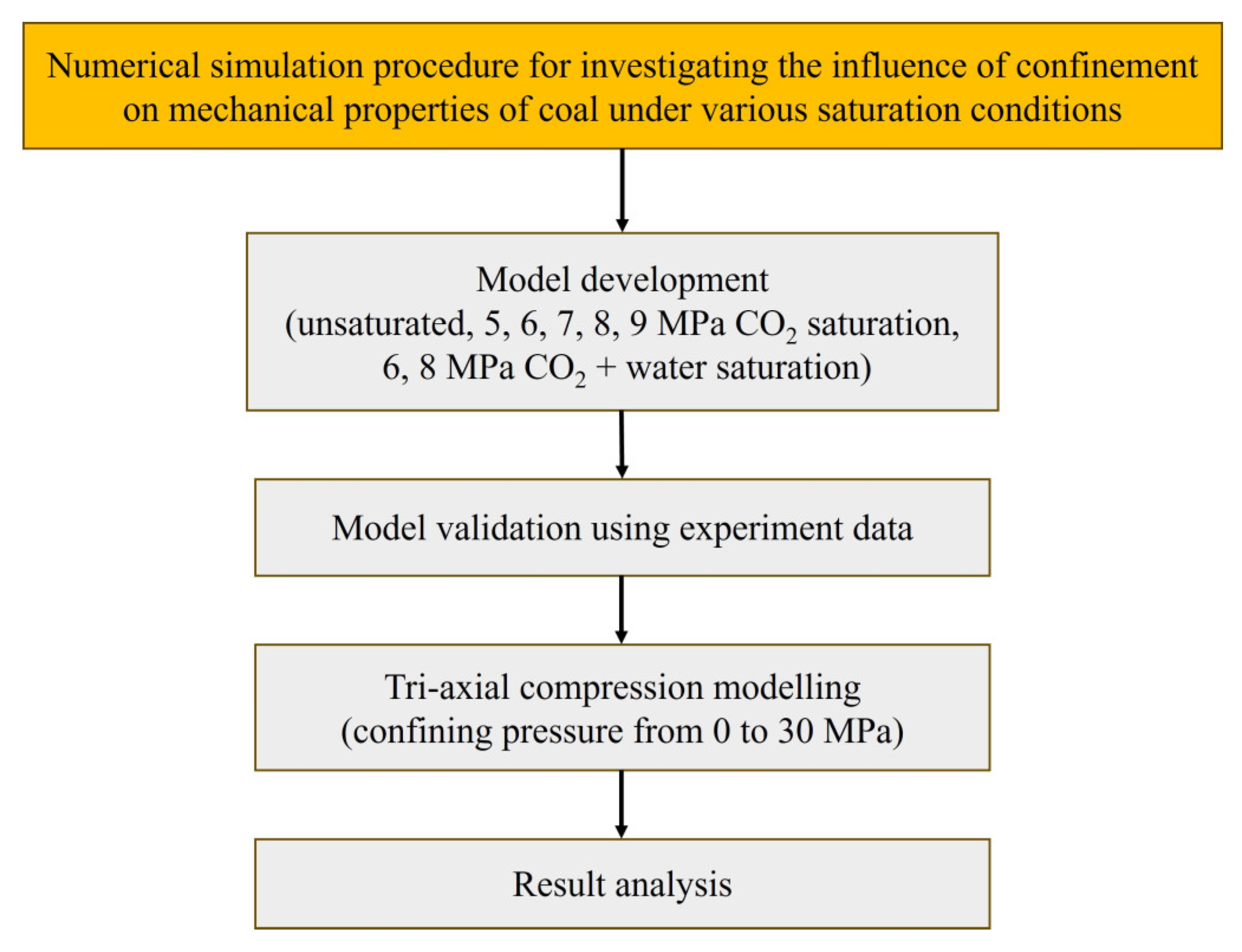

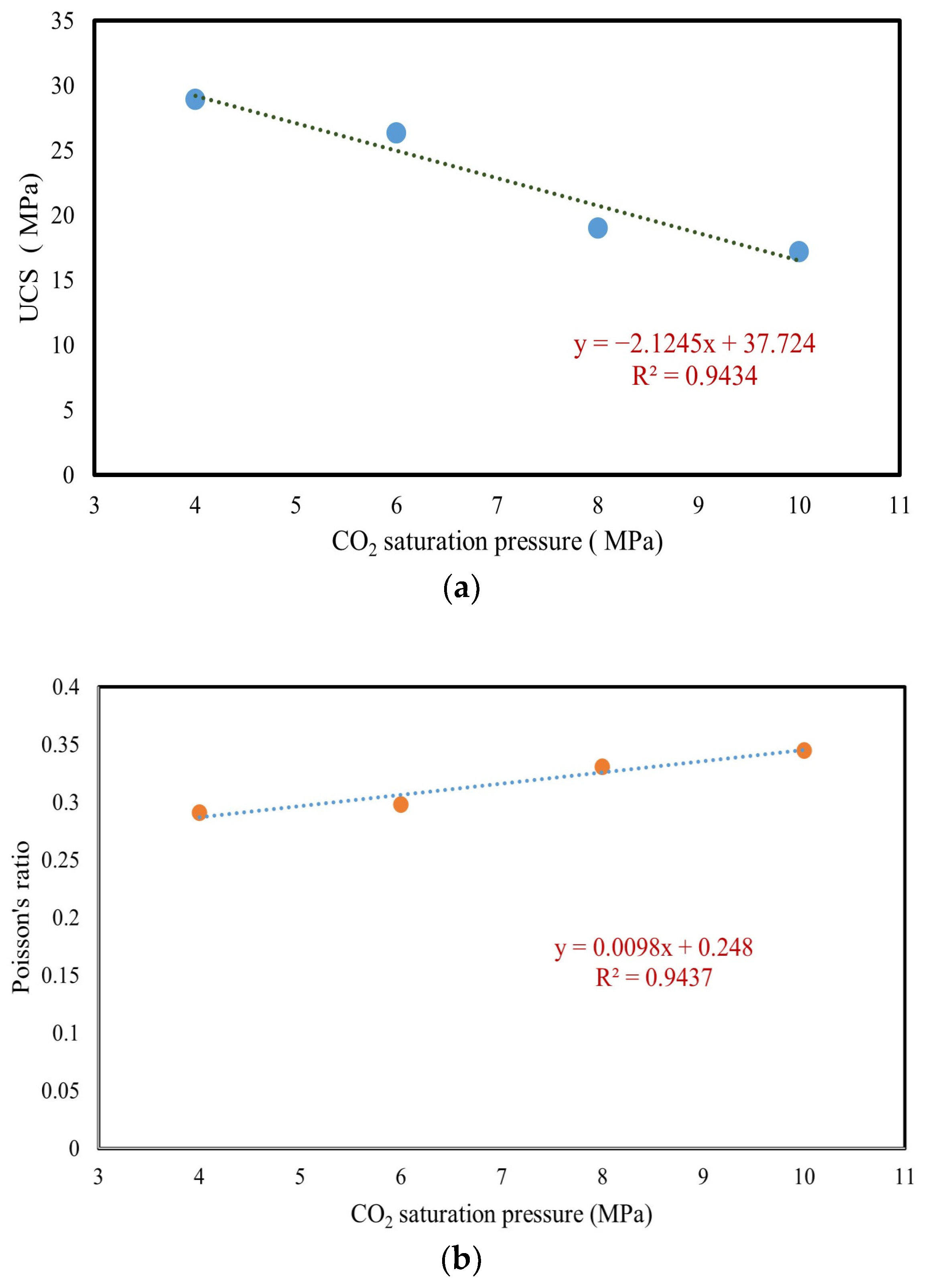
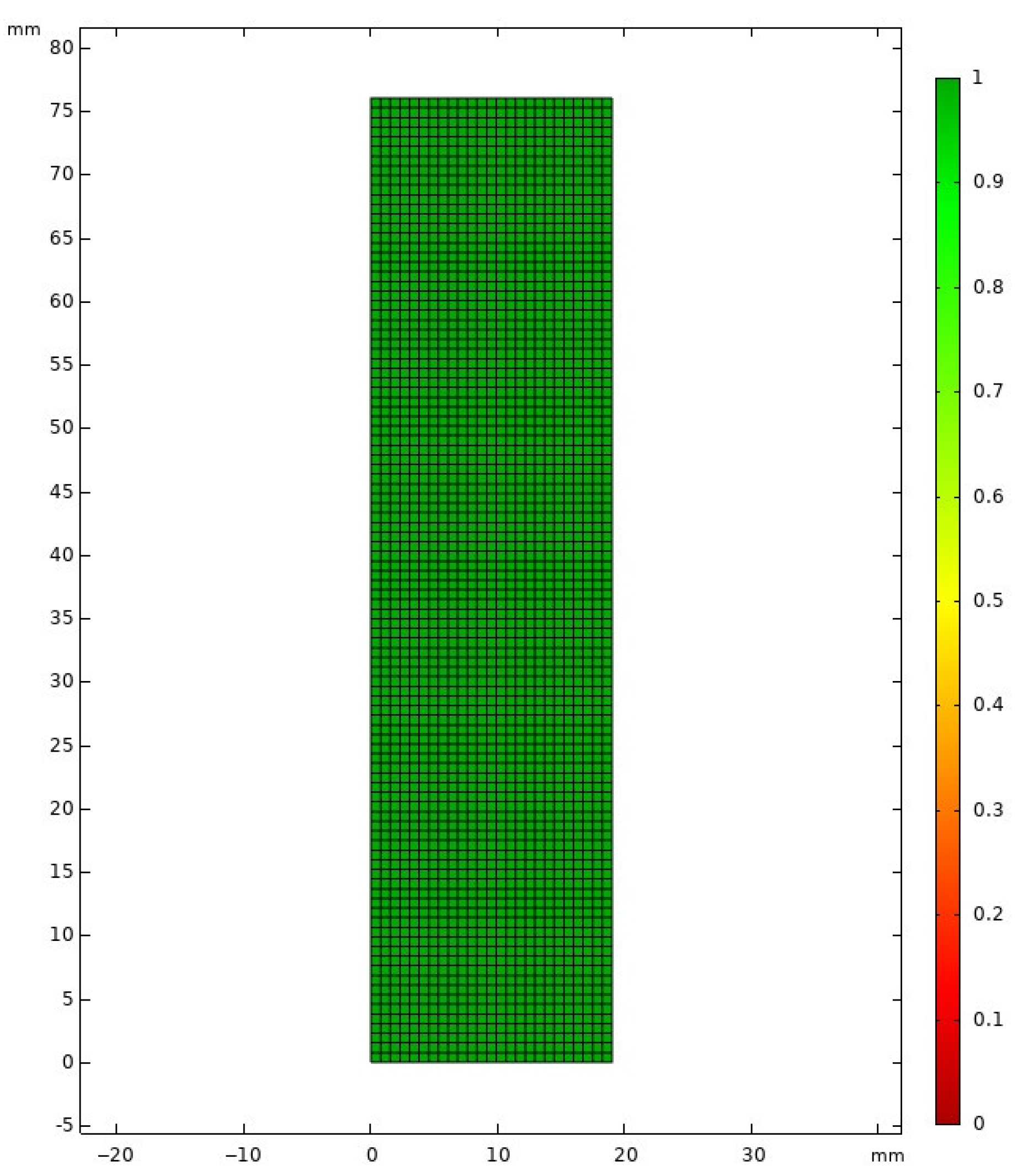
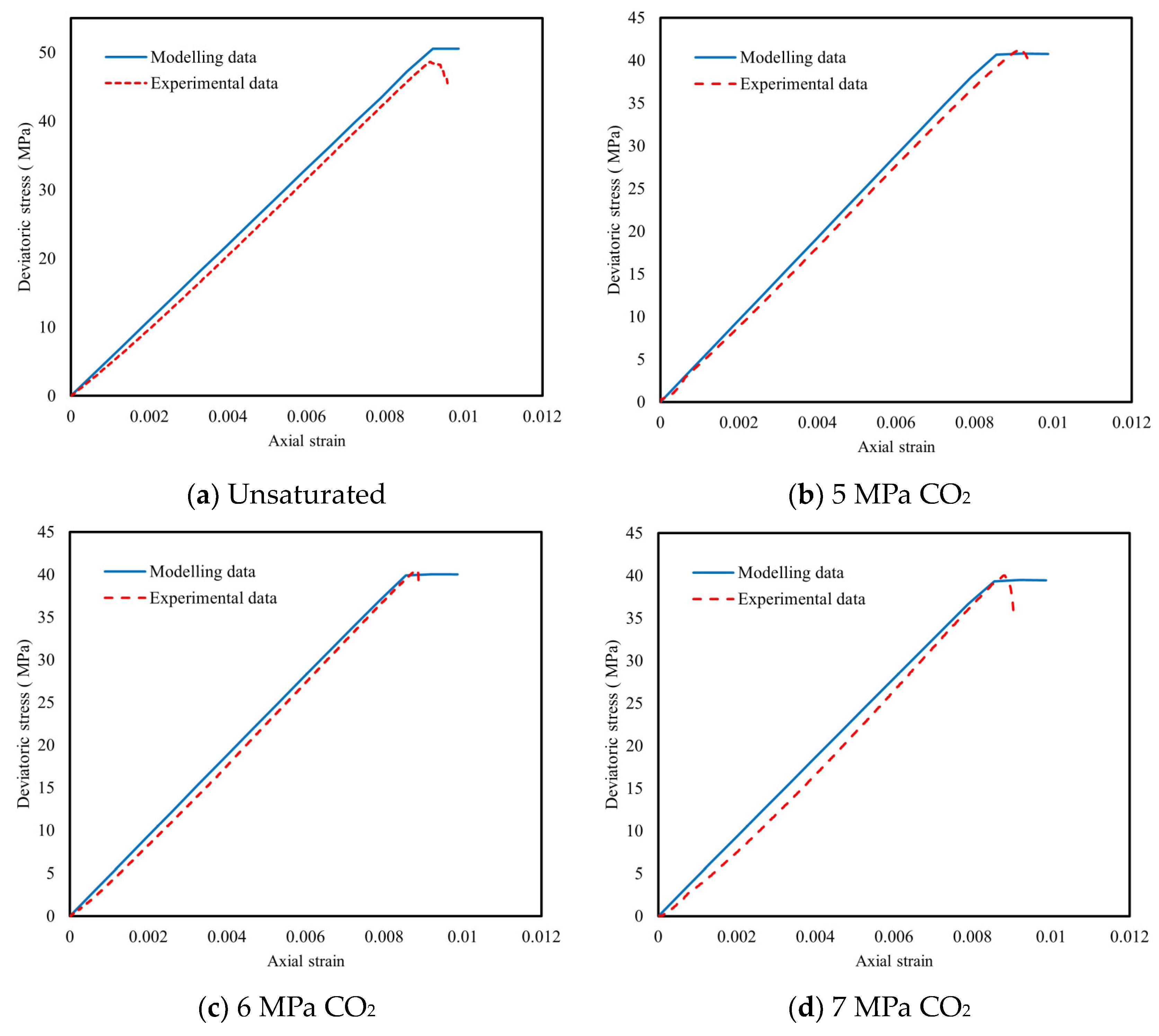


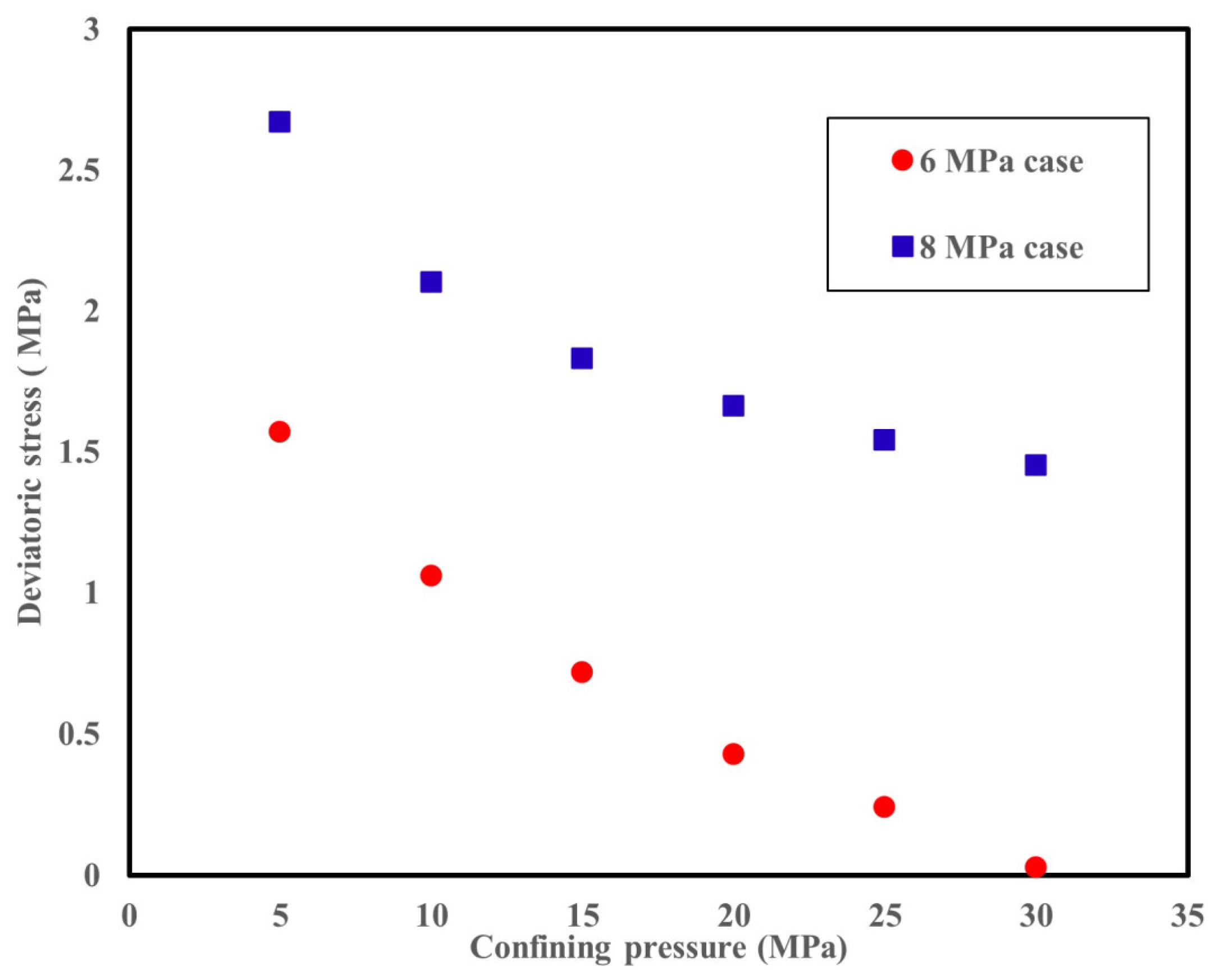
| Sample Diameter | Sample Length | Density | Confining Pressure | Prescribed Displacement at the Top Boundary |
|---|---|---|---|---|
| 38 mm | 76 mm | 1450 kg/m3 | 0, 5, 10, 15, 20, 25, 30 MPa | 2 mm |
| CO2 saturation pressure | Strength (MPa) | Young’s modulus (GPa) | Poisson’s ratio | Hoek–Brown parameter m |
| 0 | 46.07 | 5.41 | 0.263 | 0.419 |
| 5 MPa | 28.86 | 4.70 | 0.297 | 2.742 |
| 6 MPa | 26.33 | 4.58 | 0.298 | 3.278 |
| 7 MPa | 22.85 | 4.52 | 0.317 | 4.292 |
| 8 MPa | 19.00 | 4.43 | 0.331 | 5.651 |
| 9 MPa | 18.60 | 4.35 | 0.336 | 5.520 |
| 6 MPa + water | 23.90 | 4.45 | 0.321 | 3.786 |
| 8 MPa + water | 14.53 | 4.33 | 0.364 | 7.361 |
| Confining Pressure | Failure Strength of Sample | |||
|---|---|---|---|---|
| Unsaturated | 5 MPa CO2 | 6 MPa CO2 | 7 MPa CO2 | |
| 5 MPa | 46.78 MPa | 34.64 MPa | 33.12 MPa | 31.39 MPa |
| 10 MPa | 47.79 MPa | 39.84 MPa | 38.99 MPa | 38.28 MPa |
| 15 MPa | 48.78 MPa | 44.41 MPa | 44.07 MPa | 44.07 MPa |
| 20 MPa | 49.74 MPa | 48.60 MPa | 48.61MPa | 49.21 MPa |
| 25 MPa | 50.69 MPa | 52.42 MPa | 52.79 MPa | 53.86 MPa |
| 30 MPa | 51.62 MPa | 55.99 MPa | 56.65MPa | 58.13 MPa |
| Confining Pressure | Failure Strength of Sample | |||
|---|---|---|---|---|
| 8 MPa CO2 | 9 MPa CO2 | 6 MPa CO2 + Water | 8 MPa CO2 + Water | |
| 5 MPa | 29.54 MPa | 28.89 MPa | 31.55 MPa | 26.87 MPa |
| 10 MPa | 37.34 MPa | 36.52 MPa | 37.93 MPa | 35.24 MPa |
| 15 MPa | 43.79 MPa | 42.82 MPa | 43.35 MPa | 41.96 MPa |
| 20 MPa | 49.39 MPa | 48.30 MPa | 48.18 MPa | 47.73 MPa |
| 25 MPa | 54.44 MPa | 53.23 MPa | 52.55 MPa | 52.90 MPa |
| 30 MPa | 59.06 MPa | 57.75 MPa | 56.62 MPa | 57.61 MPa |
| Stress Variation | Increase of Deviatoric Stress at Failure |
|---|---|
| From 5–10 MPa | 2.16% |
| From 10–15 MPa | 2.07% |
| From 15–20 MPa | 1.99% |
| From 20–25 MPa | 1.91% |
| From 25–30 MPa | 1.84% |
| Stress Variation | Increase of Deviatoric Stress at Failure | |
|---|---|---|
| 6 MPa CO2 | 8 MPa CO2 | |
| From 5–10 MPa | 17.73% | 26.42% |
| From 10–15 MPa | 13.03% | 17.25% |
| From 15–20 MPa | 10.29% | 12.80% |
| From 20–25 MPa | 8.61% | 10.22% |
| From 25–30 MPa | 7.30% | 8.49% |
| Stress Variation | Increase of Deviatoric Stress at Failure | |
|---|---|---|
| 6 MPa CO2 + Water | 8 MPa CO2 + Water | |
| From 5–10 MPa | 20.21% | 31.13% |
| From 10–15 MPa | 14.31% | 19.07% |
| From 15–20 MPa | 11.14% | 13.76% |
| From 20–25 MPa | 9.08% | 10.81% |
| From 25–30 MPa | 7.73% | 8.90% |
Disclaimer/Publisher’s Note: The statements, opinions and data contained in all publications are solely those of the individual author(s) and contributor(s) and not of MDPI and/or the editor(s). MDPI and/or the editor(s) disclaim responsibility for any injury to people or property resulting from any ideas, methods, instructions or products referred to in the content. |
© 2023 by the authors. Licensee MDPI, Basel, Switzerland. This article is an open access article distributed under the terms and conditions of the Creative Commons Attribution (CC BY) license (https://creativecommons.org/licenses/by/4.0/).
Share and Cite
Wang, H.; Wang, Z.; Ding, S.; Jin, C.; Zhang, X.; Liu, L. A Laboratory-Scale Numerical Investigation of the Effect of Confinement Conditions on the Mechanical Responses of Coal under Various Saturation Conditions. Processes 2023, 11, 3224. https://doi.org/10.3390/pr11113224
Wang H, Wang Z, Ding S, Jin C, Zhang X, Liu L. A Laboratory-Scale Numerical Investigation of the Effect of Confinement Conditions on the Mechanical Responses of Coal under Various Saturation Conditions. Processes. 2023; 11(11):3224. https://doi.org/10.3390/pr11113224
Chicago/Turabian StyleWang, Huping, Zhao Wang, Sanqing Ding, Chao Jin, Xiaogang Zhang, and Langtao Liu. 2023. "A Laboratory-Scale Numerical Investigation of the Effect of Confinement Conditions on the Mechanical Responses of Coal under Various Saturation Conditions" Processes 11, no. 11: 3224. https://doi.org/10.3390/pr11113224
APA StyleWang, H., Wang, Z., Ding, S., Jin, C., Zhang, X., & Liu, L. (2023). A Laboratory-Scale Numerical Investigation of the Effect of Confinement Conditions on the Mechanical Responses of Coal under Various Saturation Conditions. Processes, 11(11), 3224. https://doi.org/10.3390/pr11113224





